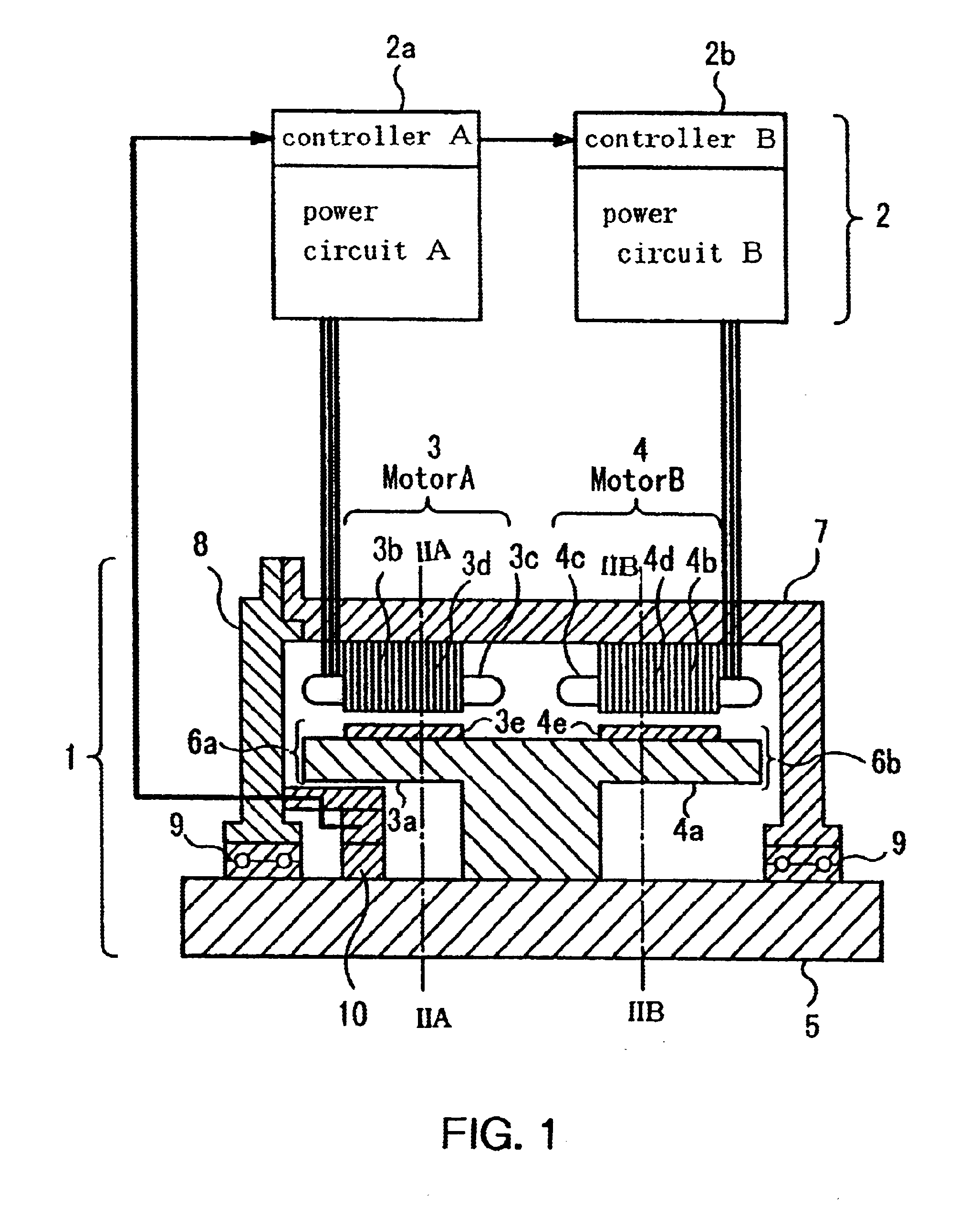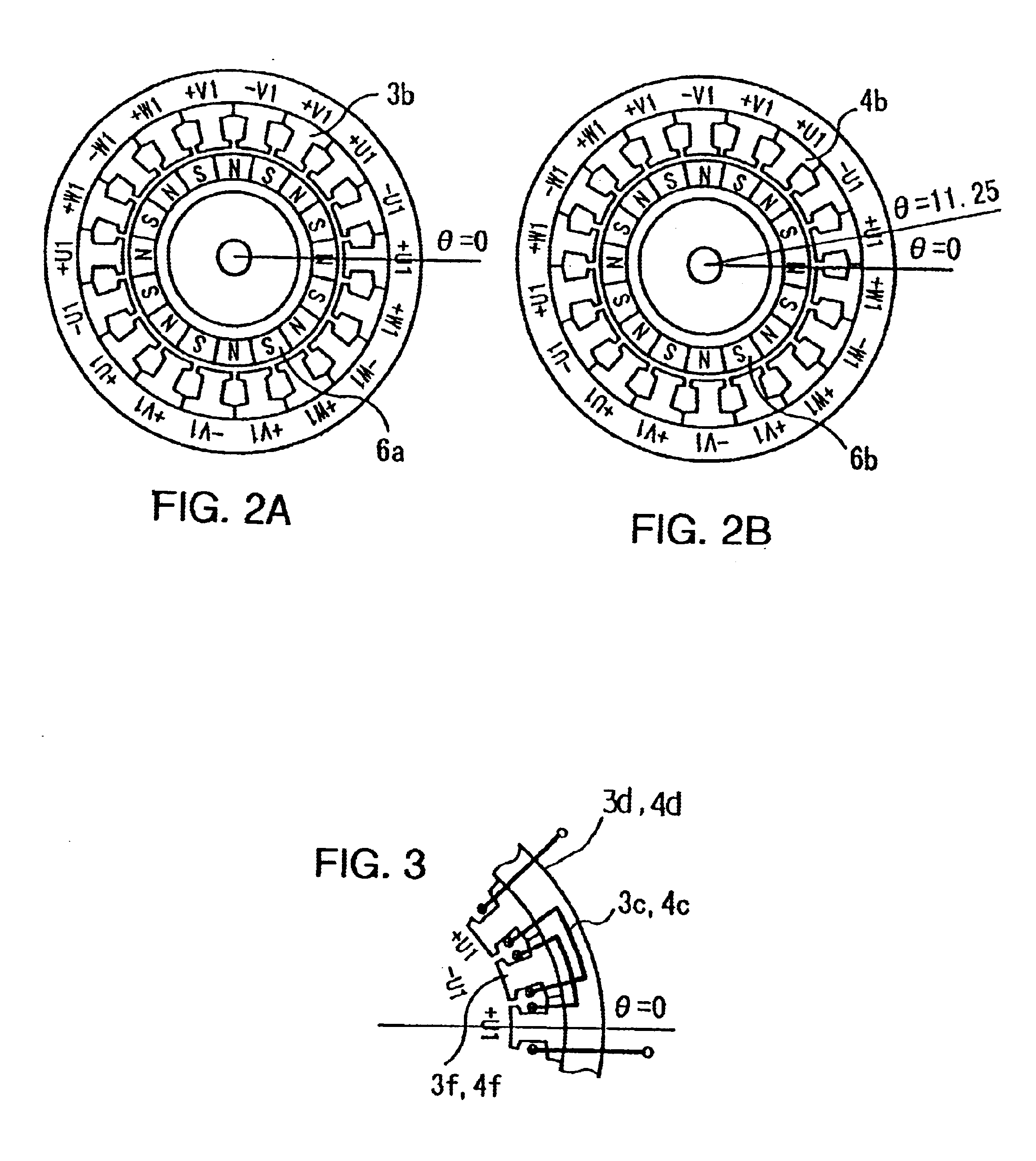Pulley driving system
a technology of driving system and pulley, which is applied in the direction of dynamo-electric converter control, multiple dynamo-motor starters, magnetic circuit shape/form/construction, etc., can solve the problems of increasing the amount of torque and difficulty in satisfying the amount of torque, so as to prevent the effect of reducing the amount of torque rippl
- Summary
- Abstract
- Description
- Claims
- Application Information
AI Technical Summary
Benefits of technology
Problems solved by technology
Method used
Image
Examples
first embodiment
Now, embodiments of the invention are described with reference to the accompanying drawings.
FIG. 1 is a partially sectional diagram showing the construction of a rotary electromechanical device according to a first embodiment of the invention, in which designated by the numeral 1 is a rotary machine section, and designated by the numeral 2 is a driver section for driving the rotary machine section 1. Since the rotary machine section 1 is generally axially symmetric, only one side of a rotary shaft 5 is shown in FIG. 1.
The rotary machine section 1 incorporates a motor A3 and a motor B4. Rotors 6a, 6b integrally formed with yokes (iron cores) 3a, 4a are fixedly mounted on the rotary shaft 5. Permanent magnets 3e are fixed to the yoke 3a and permanent magnets 4e are fixed to the yoke 4a. A stator 3b fixed to a frame 7 and the rotor 6a together constitute the motor A3 while a stator 4b fixed to the frame 7 and the rotor 6b together constitute the motor B4. The motor A3 and the motor B4 ...
second embodiment
FIG. 8 is a partially sectional diagram showing the construction of a built-in motor type pulley driving system according to a second embodiment of the invention employing the rotary electromechanical device of the above-described first embodiment. In FIG. 8, the same reference numerals as used in the first embodiment indicate elements identical or equivalent to those of the first embodiment, and a detailed description of such elements is omitted.
As illustrated in FIG. 8, a hoisting machine 11 includes a pulley section 12 provided at the center, a motor A3 and a motor B4 provided respectively on the left and right of the pulley section 12, wherein yokes (iron cores) 3a, 4a of rotors 6a, 6b of the motor A3 and the motor B4 and a pulley 13 of the pulley section 12 form a single structure which is fixedly mounted on a rotary shaft 5. This means that the motor A3 and the motor B4 are integrally mounted on a common axis on the rotary shaft 5 with the pulley 13 disposed in between.
Brakes ...
third embodiment
FIG. 10 is a sectional diagram showing a construction according to a third embodiment of the invention, in which the same reference numerals as used in FIG. 8 indicate elements identical or equivalent to those shown in the foregoing discussion.
In this embodiment, a frame is divided at its center into two parts, a first frame section 7a and a second frame section 7b. This construction makes it possible to configure stators 3b, 4b of motors A3 and B4 by shrink-fitting the first frame section 7a on the stator 3b and the second frame section 7b on the stator 4b and, then, assembling the first and second frame sections 7a, 7b. Since the stators 3b and 4b can be assembled independently of each other by shrink fit process which requires considrably high positioning accuracy during manufacture, this embodiment helps improve productivity.
As an alternative, the frame may be divided into four discrete parts, that is, first and second frame sections 7a, 7b and brackets 8a, 8b as shown in FIG. 1...
PUM
 Login to View More
Login to View More Abstract
Description
Claims
Application Information
 Login to View More
Login to View More - R&D
- Intellectual Property
- Life Sciences
- Materials
- Tech Scout
- Unparalleled Data Quality
- Higher Quality Content
- 60% Fewer Hallucinations
Browse by: Latest US Patents, China's latest patents, Technical Efficacy Thesaurus, Application Domain, Technology Topic, Popular Technical Reports.
© 2025 PatSnap. All rights reserved.Legal|Privacy policy|Modern Slavery Act Transparency Statement|Sitemap|About US| Contact US: help@patsnap.com



